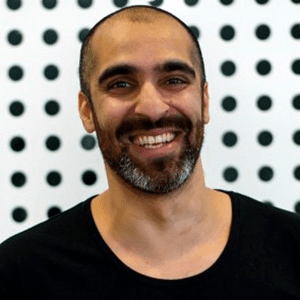

#48: Hire and retain the best people for your business
If you’re shaping a positive future for your organisation, you know the importance of having a great, connected team. In this podcast, Mark Puncher, CEO of Employer Branding Australia shares his expertise about how you can attract and retain the best talent, and keep them engaged, through employer branding strategy, employee value proposition development, storytelling and content marketing.
Mark turns recruitment on it’s head and talks about the key components of effective employer branding to help you accelerate and enhance your employer branding journey for business success.
Stephanie: Welcome to TEC Live. Stephanie Christopher here, CEO of The Executive Connection. We connect leaders with a trusted network of people who help them succeed.
Leah: It’s wonderful to virtually see Stephanie again. I would like it to be in the studio, but soon, right? Soon.
Stephanie: Very soon. I think this the last one, not in the studio.
Leah: I’m very excited. So who are you talking to today?
Stephanie: So today, Leah, I’m talking to Mark Puncher and we’ve got a very relevant, and interesting topic on employer branding. So Mark, he’s an employer branding and culture specialist. Mark’s run employer branding and marking communications operations in the UK and Australia for recruitment and media organisations, and loves helping fantastic, imperfect organisations bring their stories to life, to attract and retain their future superstars. Love it. Mark Puncher. Welcome to TEC Live.
Mark: Thank you for having me.
Stephanie: Oh, it’s great to have you here and a topic… I know we’ve spoken before and I love your passion, and enthusiasm for this. All right. Let me hit you with something. You’ve got a marketing background. Is this just marketing by some other name?
Mark: Great question. Look it. There’s some fundamental marketing principles that can be deployed for great employer branding, but I would argue absolutely not. The fundamental is this is about people, your people. First of all, marketing for product or marketing to consumers, it is about a purchase of some kind. Here, we’re talking about a decision for your job, for your career. Given how much time we spend at work, given how much time we spend thinking about work, and given how much we’re affected by our work, I think it’s a much deeper and more complex situation.
Stephanie: Okay. So why don’t we have a chat about what employer branding is and then, there’s got to be some topics about how it’s relevant now or what the challenges are now, in this world we find ourselves in. So give us the 101, Mark. What’s good employer branding look like?
Mark: Well, look, actually, it’s hotly disputed. There are plenty of people and agencies out there that will talk about campaigns. They’ll talk about PR and good news stories in the media about your organisation. I disagree fundamentally, as you probably would expect me to say. Employer branding is about understanding who you want to have in your organisation, who you want to work for you; really understanding, connecting with the people you already have; shaping the culture that you have in the organisation and your talent offer, and then really articulating that, and amplifying so that you can (a) attract the people that you need; (b) ensure that they are joining you with their eyes open and as engaged about the challenges, as the nice stuff; and (c) that you can retain those people, but not just retain them… People stay in a job because they’re too afraid to leave or because they’ve got a lot going on in their life, but actually keep them engaged and inspired to perform. That’s what great employer branding is, but it starts with understanding your people.
Stephanie: I love that. And I’m hearing, understanding your people and your culture. And so it might be understanding the people you have now, but you’d really have to be understanding where you’re taking the business, so you’re understanding what you’re looking for.
Mark: That’s right. I think the biggest issue that the employers have, or the biggest mistake they make around anything, not just employer branding, but recruitment, for example, is they feel the need to be perfect. So they feel the need to show this wonderful product that is: ‘Come and work for us.’ You see these job ads, ‘Make a difference, supportive culture.’ It’s all just the same old nonsense-
Stephanie: Career opportunities, massive career opportunities-
Mark: Unparalleled growth opportunities. Just absolute nonsense. And the market knows, candidates know not to believe you. What we need to do is to, particularly for leaders, my message is get comfortable with the fact that you are fantastic imperfect. Yeah. Be comfortable with the fact that you are not going to be a great choice for everyone and that is okay because the people who aren’t going to really benefit from your talent offer, the people who aren’t going to love working for you, are also the people who aren’t going to thrive in your organisation. This is a relationship, a deep relationship. So again, understand who you are right for, understand what matters to them, and try and really serve that and deliver that, but don’t try and be everything to everybody.
Stephanie: I really like… Pat Lencioni talks about in a recruitment process, killing someone with sincerity.
Mark: Absolutely.
Stephanie: If you’re looking for your next career step in the next three months and to really… Then this isn’t the role for you. Yet, if you are looking for bang, bang, bang, then that’s what it is. So is that what I’m hearing from you?
Mark: Oh, that’s exactly it. And you know what? The market, and I said, market candidates, respect you for the honesty. We produced some amazing videos and written stories with employers where you have a leader saying, ‘If what matters to you is X, Y, Z, maybe we’re not the right choice. But if you care about this…’ One example… And it’s not just you offer it or you don’t, think about growth or development or progression, right?
Stephanie: Yeah.
Mark: That can mean lots of different things. In some organisations, that can mean learning and development; it can mean really wonderful acceleration of your knowledge, enrichment of skills. In others, there’s not formalised training, but there is a huge opportunity to jump in, grab it, own it, and have your resume say, ‘Wow, I did that.’
Stephanie: Yes.
Mark: ‘My own little organisation. We’re pretty small. We’ve grown pretty fast.’ But the big thing we offer around that is, again, that opportunity to learn alongside really experienced leaders, cause you sit next to us, and the chance to grab hold of this thing, own it yourself, and build a resume on the back of it. What we don’t offer is conferences every other week. You know, that’s just not something that we can-
Stephanie: International travel. Well, no one’s offering that. But yeah. So, I’ve heard about: understand your culture, defining what good looks like for you or what you’re looking for, being authentic. What else is important when you are building a whole story about your business?
Mark: Well, the unsung hero is process. So often in business and strategy, that’s what it is. Nobody wants to really talk about it, but it is quite a fundamental thing. To sort of understand… Make the plan, start with that audience. Who are we trying to engage? How are we going to go out there and start a conversation with them? How are we going to continue that conversation? How can we add value to this audience? So not just that a plan and a strategy, but actually, what is the process? Who’s going to do what, and when, and how do we embed this as standard rather than just a heavy lifting strategic project?
Stephanie: Right. Okay. So that’s really interesting. You are getting here into recruitment then as well. Aren’t you? It’s not just the front end.
Mark: A hundred percent. The focus here is, and this is what I sort of talk about quite a lot, it’s not about employer branding in its own right, as its own sacrosanct discipline; it is a skill, it is an art, but it touches everything. And the way I think about it is not through the organisation’s process, recruitment, retention, employee engagement, I think of it through the journey of the employee. So the candidate journey.
Stephanie: Ah-
Mark: Pre-application all the way through to actually saying yes. That onboarding, those early few weeks that are so critical. And then what happens is, as somebody progresses to the organisation, all the way through to what happens when they leave. Really healthy businesses, you can normally see it in how well they exit their leaders.
Stephanie: So, who owns this then in the business? Who… Because I… At first, you’re thinking, ‘Oh. Well, it’s marketing because it’s the stories and the pictures, and whatever’s on the website. Then I’m kind of thinking, well, it’s head of recruitment or talent management. Then I’m… So, who owns this?
Mark: Well, I’m going to say something little bit controversial here, but who owns people in the organisation? Who should be most accountable for having the right people in the organisation, having them feel connected and performing? The CEO.
Stephanie: Yeah.
Mark: It’s the CEO. And I’m not saying that the CEO needs to do it, do everything. It is about empowering people. But for me, the operational side of it, is combining people and culture, talent, attraction, and recruitment, if that’s separate, and marketing and comms.
Stephanie: Yeah.
Mark: So that stuff is really important, but actually, the accountability stops with the CEO. Every exec team meeting, first item on the agenda should be people.
Stephanie: Okay. So when you’re talking then about doing that employee experience map, from before they even join you right through till they leave you or return or refer other employees, that’s an exercise then that I’m hearing the CEO needs to own. And then there’d be a lot of people in the organisation involved in that.
Mark: Absolutely. And we know that owning doesn’t mean doing everything, again. I know that CEOs have a lot on their plate and most of them, if they’re anything like me as a CEO, they’d be incapable of much of the detail anyway. But the inspiration, the prioritisation, the expectation… If you are sitting there, even with a small business, and your HR manager does everything, recruitment, payroll, office parties, bringing in the biscuits, then you’ve missed the point. Employee… What is it Richard Branson says? ‘Look after the employees and they’ll take care of the customers.’ It’s obvious, right? So… But why are we… Why don’t CEOs know their organisation’s talent strategy? Why isn’t there one? Even if you’ve got a small business, even if you’re not recruiting that often, I’d argue, especially if you’re not recruiting that often, you need a talent strategy because when you do need to recruit, you’re not mobilised. In terms of employee engagement, if you’ve got people leaving and you don’t really know why, well, find out. Understand what’s going on.
Stephanie: You said a magic word before. And that was ‘attracting’ people. Because since McKinsey spoke about war for talent in, I think 2000, it’s never changed. It’s never changed. And the biggest challenge for CEOs, small businesses, businesses, whoever’s doing it, is finding it and attracting the right people. So how can employer branding help you attract people?
Mark: That’s a great question. I will say McKinsey, with ‘the war for talent’… The new one is ‘the great resignation’, which is happening in the US and Europe, and they’re saying, it’ll probably come here early next year. Look, I don’t love the hype of those phrases, but the reality is we’ve always had these same issues. So not only attracting great people, but keeping the ones you have. I think, to answer your question though, around the attraction piece, employer branding is a really simple way to think about it. If you want to sell a product, if you want to bring clients on board, you don’t do it just by pitching all the time; ‘Here’s our product, here’s the price, buy it.’ So if your LinkedIn feed basically just says, ‘We’re hiring, we’re hiring, we’re hiring. Do you want the job?’ You’ve missed the point completely.
It is about taking a longer term view, a more strategic view. It is not about softening your focus. This should be absolutely tangible in terms of ROI. But where it can help you is… And we talk about three levels: employer branding, recruitment marketing, and recruitment advertising. Recruitment advertising is fantastic. It’s so important that your ads are great, that they really speak to the audience, that you’re getting in front of people with it, but they should be the conversion point. They should be the fluctuation in your conversation. What you need to do with employee branding is: first of all, again, get the deep insights and understanding, then build that into the right proposition and the messaging, and then get that content and storytelling out there, which is just a fundamental part of talent attraction. But essentially ensures that you are front of mind for the talent that you want. Just like with customers. Most businesses who sell stuff, the goal is to have customers and potential customers be aware of you-
Stephanie: Yeah.
Mark: To drive up the brand awareness, to drive up the brand appreciation, and then convert that into sales. Apply the same principles, engage the talent that you want for the future, now. Have that conversation be front of mind and then convert that. And even if somebody has never heard of you before… A lot of small businesses listening to this. I feel your pain, but you do have a great opportunity to be David in the David and Goliath situation here because you can really showcase your culture without having to have five steering groups and go through lots of committees.
Stephanie: And how do you do that in a way that… You’ve spoken about LinkedIn… And in a way that’s going to have you noticed? Because something that I flip past on my LinkedIn feed is, ‘Congratulations to our team, winning the … award at the award ceremony.’ And there’s a lot of awkward people in a semicircle at an event.
Mark: Yeah.
Stephanie: How can you really get cut through on a platform like LinkedIn then, to be showcasing the way you operate with your team.
Mark: There’s a fundamental question that you should ask yourself before you post anything on LinkedIn, whoever you are: will they care? Will audience that’s looking at this care. And part of that is: what’s my actual motivation? If your motivation of putting the post up about your people winning an award is actually to say, ‘Aren’t I amazing?’ Or ‘Isn’t my company amazing?’ Again, you’ve got it wrong.
Genuine content of, let’s say, employers or leaders about their team, showcasing these amazing people and why they choose to work for an organisation, and then getting out the way, that will cut through. The other point, that’s really, we’re seeing a lot of increasingly in Australia and New Zealand, but it’s been going on in Europe and US a long time, is user generated content. So employees who are out there, off their own back, with their own voice, talking about why they do what they do. That stuff really cuts through. Last, sort of, very practical tip around that: will they care? Nobody cares about a day in the life, ‘Then Ted turns the machine handle, and then he does this, and then Stephy gets her bar charts out.’ Nobody cares. What we want to talk about is the human in their story. That is what is actually powerful. People want to talk about people. People want to read about people. People want to see people.
Stephanie: So let’s keep going down this path. There’s LinkedIn. And so I’m hearing about people again, authentic and great if it comes from the team; they’re really good stories. What other avenues have you got? I guess you’ve got your website.
Mark: Yeah. There’s all sorts. I mean, the career site is very important in the overall website. We talk about the shop front, first of all. So the way I always think about it is: a great candidate sees your job ad, said they’ve never heard it before, first thing they’re going to do before they even get to paragraph four or bullet point 6 is to actually go and check you out. They’ll Google you. So what comes up? Google yourself, now. Google the company name and careers or jobs, whatever-
Stephanie: Straight up. LinkedIn and then…
Mark: Exactly, so. And LinkedIn… Plenty of the jobs boards, they’re all trying to steal your traffic and dominate. So your career site really matters. And the more you can put fresh content that’s well optimised for SEO, search engine optimisation, the better. But think beyond that as well. And it’s not just LinkedIn, for a lot of employers listening to this, LinkedIn can be more effective than you might think. For example, aged carers or hospitality stuff. So there’s lots of power there still, but what about Facebook? What about Instagram? What about TikTok? There’s lots you can there. The dreaded word TikTok could send shivers down your spine.
Stephanie: That’s horrifying.
Mark: But, also think beyond that, think about, especially if you’re in local areas, regional areas, think about local. Think about, I’m still a fan of the local notice boards, still a fan of the community groups. What about your own people as word of mouth?
Stephanie: So how do you pull together… Well, a couple of things. One thought is you want to make sure all your team has a good look and story on LinkedIn, don’t you?
Mark: Absolutely. But, again, I’d argue, don’t try and curate the authenticity, as I say.
Stephanie: Yeah.
Mark: So there’s a lot of… You can do a good plan. You can set this stuff up. But, for example, telling people what to say, sending down posts that people should post, just not cool. It’s not going to work. It’s never going to cut through. I think it’s about… I mean, my view, first of all, is that somebody’s LinkedIn profile is their own.
Stephanie: Yeah. It is.
Mark: So it’s about giving them an opportunity and a voice and, encouraging people. One of the things that we help organisations with is we build advocacy teams or storytelling teams.
Stephanie: Yeah.
Mark: So employees from across the organisation come together and share stories, and they talk about what content they want to create and share, with the goal of attracting great people to work alongside them, and with a goal of really amplifying, and embedding great culture.
Stephanie: I was going to… As you were talking there, Mark, I was thinking that must be culture building: to include your employees in, ‘What do we like here and who do we want to bring in?’ That’s like-
Mark: Absolutely.
Stephanie: And it’s got to help employees then refer other people if they’re clear on what you’re looking for.
Mark: You know what I hear all the time organisations saying, especially smaller ones saying? ‘Once they come, once they get in here, they love it. But how do I get them in here?’ Well, this is how you do it. And you’ve hit the nail on the head. I think it’s saying, not separating recruitment from employee experience or culture, melding the two. When you can connect with your people and keep improving the organisation and involving your people in that journey, everything else will start to take care of itself. Then it is just that wonderful process piece of, I guess, embedding the system, the rhythm, to make this stuff happen.
Stephanie: Mm. Really interesting. I think we have to touch on ‘the great resignation’. It’s getting some air time, isn’t it? It’s a thing when all the smaller, medium size business owners and leaders I’m talking to are desperate to find talent. This kind of sounds a bit counterintuitive. What’s going on? What’s this about?
Mark: Well, it’s a bit like a sports game, right? You’re so busy trying to score goals, and then you let three in at the other end. And it’s hard. There’s quite a lot going on here. I think, obviously, employers who aren’t great employers for the people they’re targeting and they’re talking to, but employers who don’t deliver that great customer experience… Employee experience, excuse me, are going to struggle. And, you know what? Rightly so. This should be a catalyst to improve your organisation and not to be perfect, but just to really connect. So there’s that. That people, for example, who were treated pretty badly during COVID by their employer, now’s the time when they’ll jump ship and they won’t have any qualms about leaving in the lurch. And if you expect loyalty from people that you haven’t truthfully shown loyalty to then you’re dreaming. There’s something that’s a lot more, I’m going to say, unfair, though.
And it is what it is. There’s nothing we can do about it. There’s a malaise. And I feel for… I’m based in Brisbane and feel very lucky and grateful. I really feel for those in Melbourne and Sydney, and elsewhere, there is a malaise, there is unhappiness, and rightly so. There’s people really struggling, even people who are struggling and who have it okay, relative to others-
Stephanie: Yeah.
Mark: They’re fed up. They’re sick of it. And we’re humans, we take that out on someone, someone or something. Usually we take it out on our job and our employer. We’re fed up with it. So, that malaise is driving a desire to just change. And the fundamental point is, it’s not just, ‘Oh, I’ll switch this job for a similar job.’ It’s people going in, ‘You know what? I don’t want to work this hard. I don’t want to do a full time week. I want to work half the hours. I’m going to find a new way to make an income. I’m going to settle for a lower income.’
For years, we have this thing that we basically traded in our time and our energy in order to buy things; a big house, or a bigger house, the jewelry, fashion, whatever. What’s happening is people are saying, ‘Actually, I’m going to rethink that trade and that transaction. I’m going to have less so that I can work less so that actually I have more in terms of my lifestyle and what I have.’
So, biggest advice, it’s a big thing to say, but the biggest advice to employees is rethink. Rethink your talent offer. If you think that people can’t work from home in your organisation, in many cases, you’re probably wrong. Of course, there are some roles where the employee needs to be in a certain place. If you think you can’t do flexible working of any kind, then you’re wrong. There are always ways to find new approaches. And you’re going to have to, because the way people work, what they expect, what they want, what they will tolerate, has changed, and it’s going to keep changing even more.
Stephanie: Yeah, I think that’s absolutely true. And I love my conversations with Maja Paleka from Juggle Strategies about exactly this. Will, the future of work… I mean, it seems so cute the conversations we had in 2019 compared with what we’re having now. And I think as a leader, it’s about being very intentional about the future and not just letting it land or you just stumble through. I think it’s a great opportunity for employers to take stock now and say, ‘Well, this is what we’ve been through. This is what we’ve learned.’ And what I’m hearing from you, Mark, it’s then, ‘How can we integrate this as part of our offering, that’s going to be appealing to my own team, the future team members.’
Mark: Absolutely. Right. And the biggest tip is break down the barrier. Stop doing it in a closed room for the people and about the people. Involve them.
Stephanie: Yeah. Yeah.
Mark: Let’s talk as a team about what this business can be and how we’re going to get there. Let’s talk about what you need in order to thrive. It’s a classic story I tell. Working from home is a great example. It used to be a gift.
Stephanie: Yeah.
Mark: From an employer or a manager to an employee; ‘You’ve worked really hard so this Friday you can work from home.’ And there was an unwritten understanding that it was kind of a slack day that they weren’t going to do as much. Absolute nonsense. It went during COVID and is during COVID a necessity, so employers are relying on their staff to keep going and giving. And we know all the data shows that consistently people are giving even more , sometimes too much.
What it actually is, is an opportunity; an opportunity to attract talent that you might not normally be able to get. A classic traditional stereotype is the mother returning to work. How much talent have we lost for years and years, and years because we don’t embrace that and enable that in an organisation. It is also an opportunity for people to be well, to be better, to feel connected, not just grateful. I’m grateful because you let me work part-time. What nonsense. Actually, I have the arrangements I need, the hours I need, the work flexibility I need, to really nail my job, to help this organisation succeed. But that comes from trust and understanding.
Stephanie: There’s a real rewriting of the psychological contract that is happening and really needs to happen, now, I think.
Mark: Yeah and employers have gotten away with it for a long time, and I don’t mean to be mean and unkind. Cause it’s hard. I run my own business. It’s really hard.
Stephanie: Yeah.
Mark: But the truth is that… And this isn’t, ‘Yes, the market will change at some point, think it’ll become less candidate driven.’ But it won’t change that much.
Stephanie: Right.
Mark: And COVID has left a mark and is going to leave a mark, and combining with societal factors where there are lots and lots of ways to earn an income and where maybe we finally self-actualized or many people, self-actualized the point of saying, ‘You know what? I don’t need to earn that much at this cost.’
Stephanie: Interesting. So with all that in mind and everything we’ve learned, I’ve learned a lot in the last 25 minutes… So this is putting you on the spot, Mark. Top five tips for setting up or getting yourself in the right place for a really strong employer branding proposition.
Mark: Sounds like a good challenge to take on. Thank you. I’m going to count on my fingers. I’m going to… I’m obviously going to say, and I am of course biased, but use a partner, if you can. There’s no doubt you will get better results and so on. It’ll be easier for you. But let me focus these on if you can’t. Let me focus these on if you’ve got no budget, no time, whatever else, you just want to get started and do something. Number one, ask your people why they work for you.
Stephanie: Mm.
Mark: Why do you keep coming back? If you left tomorrow what wouldn’t you miss? What would you miss? So just, next 10 people you talk to, just ask them. You will learn a huge amount. And make sure they know you’re sincere. So ask them and listen. The next thing you should do, I think is pull up those job ads you’ve got. If anybody’s interested, go on YouTube and search ‘EBTranslate’, all one word, and you’ll find a little video we put together taking the Mickey out job ads.
The cliches that are in your job ads right now, most people in Australia, it’s just hilarious. Competitive remuneration. What a great way to tell people you don’t pay very much. ‘Supportive culture.’ What does that mean? ‘Fun culture’ means ‘it’s not very fun here.’ So, go and check that out, but bring up those job ads; the answer isn’t to suddenly create something lofty and aspirational. Actually understand, apply what your people have told you about why they work you and put that into your job ads. That’s number two. Number three, build a plan around how you’re going to engage with talent, not to fill the role you currently have, but to actually make recruitment easier and get better results for the next two years.
So it doesn’t… It can be on a napkin. It can be on one page. But number one on that plan is, ‘Who are we actually trying to engage?’ Once you understand those people better, those audience segments, or those personas, those typical people that you know should thrive with your organisation, you’ll be able to actually consider your pitch to them and how that works together. So that’s number three. Number four, storytelling. So content, content, content. So we help organisations with this stuff all the time, but even on your own, don’t just put out a job ad. Put out a job ad and have a story from somebody in your organisation who’s doing the job. ‘Hey, everyone we’re hiring right now for or an X into this role. Here’s a story from somebody who actually you’ll sit next to if you join this organisation about why they choose to work for us. Here’s a video, short smartphone video, from the hiring manager saying why they’re actually looking forward to hiring this role right now, what they think is exciting and what they’re looking for.’
So that’s number four, that’s storytelling and content, and number five is measure. Measure wherever you can. Something that so few organisations do well is score candidates. Even if you don’t have intricate systems and so on; even if you count how many people you have, who are not an immediate thumbs down. We know that when we recruit, with a lot of people who we reject quite quickly and hopefully that’s done respectfully and so on, but just at least understand how many people are we attracting that we are considering, that we shortlist and look at how that changes over the time, over time, because all of this thing, if you’re going to put time into this, if you’re going to put energy this, if you’re money into this, you need to see results.
Stephanie: That was so interesting and some great learning there. And as always, I say, if you’re listening to this, go back and listen again and get those, get those five top tips. Mark, I love that question. If you left tomorrow, what wouldn’t you miss? And what would you miss about the organisation? And that was really, really good.
Mark: Thank you. Can I give you one follow up on that when they answer?
Stephanie: Go.
Mark: When they answer you, don’t let it stop there because they won’t tell you the truth the first time.
Stephanie: Oh yeah. Right.
Mark: What they’ll say is, ‘I’ll really miss the people. I love the people.’ My response, when we interview people for this stuff is, ‘Come on. Everyone says that. Either sell it harder or tell me the truth.’ And they’ll usually go, ‘No, no, no, I really…’ And then it’s saying, ‘Okay, what does that mean? What are the people like then? What is it you’ll miss about the people?’
‘I love it because I make a difference.’ ‘How do you make a difference? What does it feel like to make a difference?’ This isn’t a Q and A lip service checkbox. It is about a deep understanding.
Stephanie: That’s really interesting. Really interesting. So apart from the top five, I’ve learned, well, I’ve learned a lot, but I think the main takeaway from this, Mark, is that this is an end to end consideration. That it’s about defining who you’re after, being very clear on what you look like internally; it’s about the experience of people that are coming into your organisation and the people that you do want to retain in your organisation. And as everything, it really needs to come back to leadership and the role of the CEO in driving, and living this all the way along. Mark, that has been such an interesting conversation. And Mark Puncher, thank you so much for joining us.
Mark: Thank you very much for having me. I love your work.
Stephanie: Discover more about TEC.



